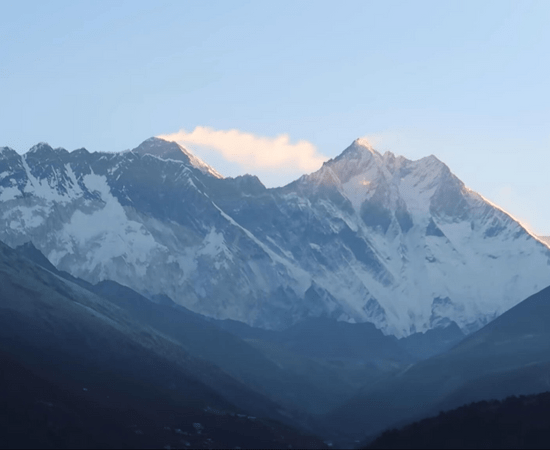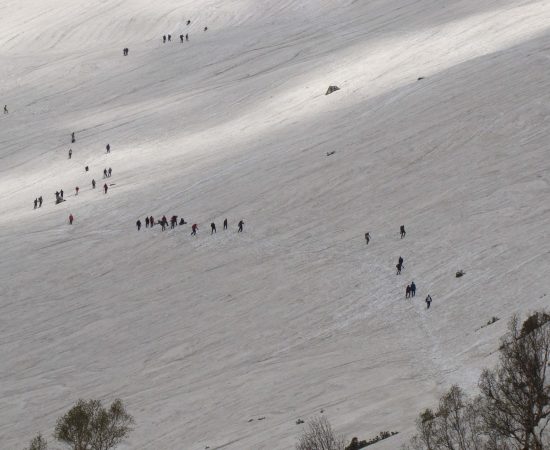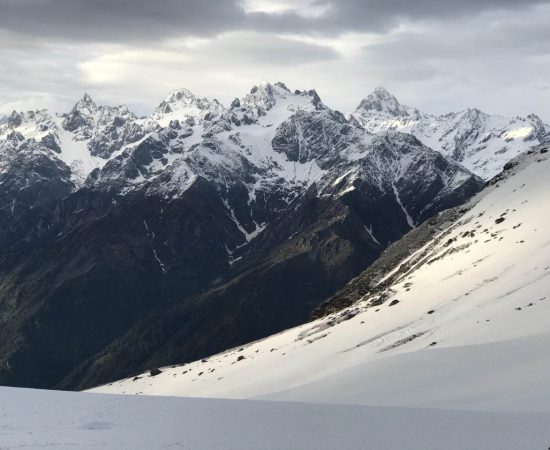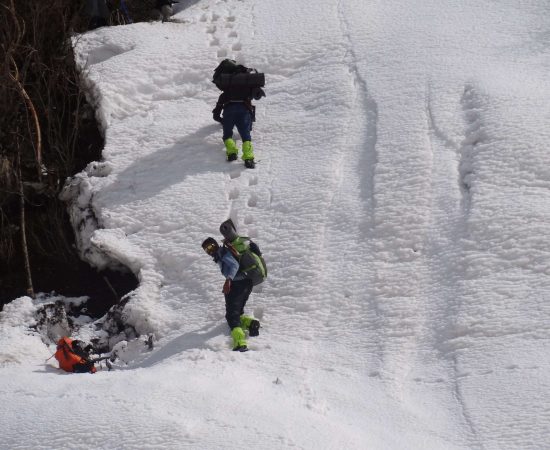Rupin Pass Trek
Dhaula, Uttarakhand
Rated 4.9/5.0 on TripAdvisor. 550 Reviews


Key Highlights
- Altitude : 4632 mts
- Time : 8 Days - 7 Nights
- Region: Dhaula
- Best Time: May,June,June,September
- Distance: 52Kms
- Grade: Difficult
Overview
Rupin Pass Trek
The journey from Dhaula in Uttarakhand to Sangla in Himachal Pradesh is known for showing the different natural splendour of the Himalayas. You may hike through lush rhododendron and pine woods, meander along the Rupin River, traverse sizable glacier basins, and eventually ascend up the tiny gulley of Rupin Pass to reach Ronti Gad on this one-of-a-kind journey. This journey is ideal for hikers who have completed a few hikes and want to go from beginning to intermediate level hiking. Trekking from Uttarakhand to Himachal Pradesh is a steady ascent that aids in improved acclimatisation of the body. This provides the ideal environment to take in the breathtaking scenery and the variety of flora that this trip has to offer. This area progressively gaining prominence and draws hikers from both within and outside of India. You go the whole route beside the Rupin river. You will be able to see the river's changing mood as we begin along the banks of the Rupin River in Dhaula, hike through camps, and then ascend to the Rupin Waterfalls at the river's source above Ratapheri. While the remainder of the hike is in Uttarakhand, 80 percent of it is in Himachal Pradesh. Come see the drama play out as the Rupin Pass Trek leads you from Uttarakhand to Himachal, providing you with stunning colours and the need to scale snowy cliffs. The villages you pass on the approach to the pass are all distinctive in their own right. A god resides in Sewa, whose temple only opens its doors once a year for a highly celebratory event. One of the nicest vistas one can see is from the settlement of Jhaka, which is perched on precarious mountain ledges. Either May–June or September–October are the ideal times to do this journey. And if you do get to do it in May or June, you will even discover locals scavenging for uncommon mushrooms like Cordyceps Sinensis and Morchella Mushroom (known locally as Gucchi) (called Keeda Jadi by locals).
Cost Per Person
Key Highlights
- Altitude : 4632 mts
- Time : 8 Days - 7 Nights
- Region: Dhaula
- Best Time: May,June,June,September
- Distance: 52Kms
- Grade: Difficult
Complete
Itinerary of trek
Our tour will start as soon as we arrive at the agreed-upon meeting location in Dehradun and set off on our way to Dhaula, a hidden treasure in the Uttarkashi area. To avoid being caught in traffic or any other roadblocks that may cause us to be late for our destination, we start early in the morning. Given how many visitors these hill villages draw, we will drive via Mussoorie and the well-known Kempty Falls, so be prepared for heavy traffic. We'll stop for breakfast a few times along the road, and our last rest stop will be in Purola for lunch. Remember that we won't have access to a cell network beyond Purola, so it's wise to phone your loved ones to let them know you'll be calling them again from Ronti Gad after you've through the pass. Early in the evening, when we reach Dhaula, the trip leader will give us a briefing on the hike's specifics and assign us our tents. Stay the night at Dhaula.
Soon after breakfast, the first day of our walk will start. For two reasons, we'll aim to go as soon as we can. One, it's quite hot to hike in the sun, and two, it happens often in the mountains that the weather changes in the late afternoon and there's a chance of rain. We travel on a mud road for the first portion of the journey, which is a gradual one. We quickly leave the settlement and begin hiking along mountain routes that take us through rhododendron and pine woods. The scent of the woods really lifts your spirits. We will stop in between to eat lunch and refuel for the remainder of the day's hike. The majority of today's path takes us through thick woods on gentle inclines until we arrive at Sewa. The majestic wooden temple, whose doors are only opened once a year, is one of the village's distinctive architectural features. At Sewa, we unwind while listening to the Rupin River.
Today marks our departure from Uttarakhand and arrival in Himachal Pradesh. We have breakfast in Sewa, then set off for the hanging village of Jhaka while carrying our lunch with us. To begin, we will descend to the banks of the Rupin River and hike along them for an hour. We would have reached Himachal Pradesh at this point. After a brief ascent through a sparsely vegetated area of the mountain, we reach a dirt road that is still being built. We shall walk along this unpaved route while admiring the natural beauty around us. On the mountain slopes, where farmlands and tiny communities surround the beautiful green valley, one may see the simple way of life of the locals. We'll even pass a few waterfalls along the way that will reflect the sun's rays and create rainbows. To get to the settlement of Jiskoon, the route must zigzag along a dirt road in its last section. After another half-hour of hiking, we arrive at Jhaka. Stay the night in Jhaka.
We leave the hamlet of Jhaka behind and continue climbing through woods and agricultural areas on our adventure across Himachal Pradesh. The terrain becomes extremely steep as we go into the forest, necessitating a few breaks as we continue to ascend. The forest's seductive atmosphere is truly enticing. When we ascend out of the woodland and onto another farm area, the steep terrain somewhat improves. Many residents come to the hamlet to live in thatched huts and engage in farming during the growing season even if they own agricultural areas apart from their homes. It's time to descend back towards the river and cross it after travelling along the Rupin river and through the mountains. The path through the forest is difficult, and there are often fallen trees on the track as well as steep drop portions with slick mud. We gently descend to the river and use a wooden bridge to cross it. Now that we've ascended to a respectable height, we can make out little areas of grasslands with tiny flowers that are a variety of hues, including white, pink, purple, yellow, and orange. The distance to the campground from here is about an hour, and the power of the river is strong and enormous, screaming within our ears. After arriving at Buransh Kandi, we unwind after our journey today with some tea and food. Stay the night in Buransh Kandi.
Rhododendron is referred to as Buransh in the local language, and the region around Buransh Kandi is covered with rhododendron trees of all hues. As we awaken to this stunning scene of the many hues around the valley and the Rupin river running directly through it. We will be provided with microspikes and gaiters before leaving our campground, which you will require later on throughout the walk. The valley widens as we leave this lovely rhododendron woodland, displaying the Rupin waterfalls in the distance. We wind our way through the valley, which is divided between meadows and snow-covered areas by little lakes the Rupin river has created. A steeply inclining, narrow goat route makes up the last ascent to Dhanderas. You can't help but be in awe of the splendour once you arrive at Dhanderas. vast meadow with a profusion of flowers and a stunning view of the two Rupin waterfalls. After arriving at the campground in this breathtaking setting, we enjoy our lunch. To aid our body in better acclimatising, we take a little hike in the evening. Stay the night in Dhanderas Thach.
Our journey today is quite short, yet it is still a struggle and a job. We leave our camping in Dhanderas, walk across the lovely meadow, and eventually arrive at the foot of the waterfall. Don't be hesitant; snap as many pictures as you want to bring back as memories from this beautiful place. We make our way to the right side of the waterfall and start our difficult and steep hike from there. We carefully pace ourselves as we continue our ascent to the higher cascade, taking one step after another to save as much energy as we can. The crossing we must make under the upper waterfall is extremely challenging because you must carefully balance yourself while walking on a narrow goat trail with one waterfall flowing above you and another one flowing directly beneath you. The adrenaline pumping through your body as you complete this task increases the excitement and thrill. Our next hurdle will be a difficult climb up a 60-degree slope close to the waterfall when we get beyond this challenging stretch. We can easily see our campground after the gruesomely steep climb is finally completed. Before we reach our campground, we must traverse a little area of land, which will take us around 15 to 20 minutes to complete. The trek leader will give the team a briefing on how to approach Rupin Pass and how the team will travel through the pass after a nighttime acclimatisation hike. As the Pass day will begin before the crack of dawn, eat meals early and get as much rest as you can. Camping at Upper Waterfall for the night.
Since the beginning of our voyage, we have been anticipating this day to cross the pass as the day of reckoning. As early as three in the morning, we rise up with a lot of excitement and energy to be ready for the challenging trip we will be on today. Prepare yourself before arriving to breakfast by donning appropriate warm gear to stave off the cold, using gaiters and mocrospikes as directed by the trip leader. This will depend on how deep the snow is and when we have to put on our gear. Water is not available for a significant portion of the hike, so be sure to take enough. At precisely five in the morning, we will start our journey up Rupin Pass. Our trek begins with a difficult incline and leads us to the mythical region of Ratapheri. According to locals, this location is inhabited by ghosts, and if you camp here at night, you could even experience their presence. As soon as we arrive at Ratapheri, the whole valley expands into a dome-shaped formation that is encircled by formidable mountains on three sides. We ascend from one mound to the next, pass Ratapheri, and arrive at the Rupin Pass base. We trek over the Rupin Pass's confined and treacherous gulley for a little more than an hour before reaching the summit, but that hour seems like a lifetime since it is difficult to breathe at that height. The vista is truly breathtaking at the top of the pass. Ratapheri, the valley you just traversed, is on one side, and on the other, you can see Sangla Valley and Kinner Kailash, which is just in front of us. We start our descent after taking pictures from the top of the pass since we still have a ways to go. We'll even get the chance to slide down the snow slopes on the opposite side of the pass to save time. We start to notice better grasslands as we approach Ronti Gad. We successfully arrive in Ronti Gad and set our tent there for the evening.
Finally, the last day of the walk has come. After breakfast, we pack up our bags and say our last goodbyes to the local staff members who have looked after us during the walk. Today's route is all downhill and passes through Ronti Gad's picturesque farmlands and meadows before continuing on to Sangla Kanda. Wide areas of apple orchards can be seen as we move closer to Sangla. These apple orchards are a distinguishing feature of the Kinnaur Region, and the apples from this valley are well-known worldwide. After many hours of hiking, we eventually reach the road and enter Sangla. You will board your cars in Sangla and be driven to Shimla.
Enquiry For Group Bookings
Guidelines
➽ Preparation for Trek
As you well know, the great Himalayan trek is one that requires careful preparation, a strategy that allows for enough flexibility to adapt to whatever challenges may arise.
Therefore, here are some things to consider before setting out on your trek:
⦿ Physically – You should start working out at least a month before signing up for a program if you want to be physically prepared for the rigours of a journey. Strengthen your legs by jogging and working out regularly to increase your stamina. To better acclimatise to the environment and increase your resilience on the walk, you should give up smoking and undertake breathing exercises twice a day. Engage in vigorous physical activity, such as playing sports, doing Yoga, or running.
⦿ Mentally –
Getting in shape physically is essential, but mental preparation is just as crucial for a successful walk. Take time to enjoy your regular activities, maintain a healthy diet and sleep schedule, and unwind before embarking on a hike. Predictions regarding the journey should not cause mental worry. Spend time with your closest pals to recharge your batteries and renew your spirit. Pre-trek preconceptions are unwarranted since the first contact with the other trekkers is certain to be a source of inspiration and energy. Conditions during the walk will contribute to the increase in mental readiness. The mental repercussions of physical disadvantages will not be ignored. So, when you hike, pay attention to different regions of your body and purposefully relax them. If you want to enjoy your hike, you should learn to loosen up a little, particularly in the hips. Think about your descent as a simple dance, and enjoy the natural rhythms that the path and your body can discover together gradually, whether you're on a flowing downhill route or a frightening slope. Try out a few new walking techniques to add some fun to your commute without worrying about getting somewhere in particular. Maintaining mental fitness mostly requires a willingness to relax and take in the journey, rather than subjecting oneself to undue stress.
⦿ Technically-
Get the right size hiking boots and go for it, from a technical standpoint. You should make use of 60 litres. To become acclimated to carrying heavy items, it is recommended to utilise a backpack on a regular basis. Get a hiking stick, a water bottle, some thermal socks, a fleece or feather coat, some long pants, a poncho, some flip-flops, and any devices you may need like a camera or a power bank (DSLR or digital camera).
Guidelines
➽ Things to Carry
- Good Trekking Boots: You need sturdy trekking boots with supportive high ankles. Don't bring your running shoes. U can carry extra floaters/flip flops also.
- Wear warm clothing, such three-layer coats, fleece upper, hollow fill or down-filled jackets. Carry full-sleeved T-shirt. Carry cotton hiking trek pants and warm pant for your lower body. Never bring shorts or jeans on a hike.
- Take top and bottom thermals with you.
- Quick dry towel with light weight and Personal toiletries. Suns cream lotion, sanitizer, tooth brush ad toothpaste, lip balm and antibacterial powder.
- Socks: Bring two pairs of regular socks and two pair of wool socks for wearing at night.
- A head torch is required.
- Sunglasses/ Goggle: UV-protected sunglasses are necessary to protect against sunlight and Snow Mountain.
- There should also be a woolen cap / balaclava, cap, neck gaiter cum face mask and warm fleece and waterproof summit gloves since it will be chilly. Keep waterproof gloves on hand since they become wet in the snow.
- Everyone taking part in the activity should have their own lunchbox, spoon, mug and water bottle/ hydration pack of 2 ltr.
- Raincoats/ponchos: Since snowfall and rain are frequent at high elevations, it is important to have one on hand so as to avoid getting wet.
- Trekking bag of 75 ltr with rain cover.
- Walking stik.
- Electronics: camera (optional) USB cable/USB solar charger, charger/earphones, Power bank fully charged.
- Personal first aid box. Emergency ration, energy bars, dry fruit, electoral/Ors
- Required Documents:
a) Registration Form
b) Medical Certificate (signed by a licensed MBBS physician)
c) NOC form (completed by the trekker)
d) 2 passport-size photos
e) ID Proof photo (not PAN)
g) Insurance upto 5 lac..
Guidelines
➽ How to Reach
Distance by road:-
Dehradun has excellent road connections to the rest of the country. Dehradun is linked to Nahan, 95 kilometres (km) to the north-west, and from Nahan to Panchkula, Chandigarh, and Shimla by NH72. Haridwar is the last stop on NH 72, and it's just 54 kilometres from Dehradun. From Delhi, Dehradun is 235 kilometres away. Dehra Dunk connects to Roorkee via NH58 (67 km), which leads south to Meerut (170 km) and Delhi (235 km). Delhi ISBT Kashmere Gate is where you can get a bus to Dehradun.
Location of the Closest Train Station:-
Dehradun is well-connected to other major cities in India through train, including Delhi, Mussoorie, Mumbai, Varanasi, Lucknow, and Kolkata. DDN NZM AC EXPRESS DEPARTING FROM DELHI (2205)
Closest airport:-
About 25 kilometres outside of Dehradun lies Jolly Grant Airport, the city's primary airport. From Delhi, you may take a daily flight to Dehradun.
➽ Trip Cost Includes
- Conveyance within the journey.
- Tents that can be shared.
- Advanced and knowledgeable himalayan adventure trips guide.
- Cooks, helpers, and other necessary personnel.
- Vegetarian meals (breakfast, lunch, and dinner) along the journey
- Every organisational prerequisite for a journey
- First aid kit with portal oxygen.
- Camping fees and forest permits.
- All permissions for hiking.
- All meals will be supplied while on the hike. Freshly cooked meals will include a mix of indian, chinese, and continental cuisines.
- Lodging at a hotel, guest house, home, or in tents.
- All of the group's trekking equipment (tents at base camp, use of base camp facilities)
- All trip workers, including porters and mules for everyday items (such as food, tents, and utensils)
➽ Trip cost Excludes
- Airfare or other forms of transportation costs.
- Meals and hotel accommodations.
- Personal costs include washing, cell charging, and lodge showers
- Entry permits or permission for the inner line for foreign participants.
- Personal apparel and hiking supplies, such as liners for sleeping bags and walking sticks, are required.
- Any expenditures associated with rescue efforts or an early expedition departure.
- Guides and sherpa crew are tipped.
- Personal porters to carry hikers' packs
- Personal liability insurance or emergency evacuation costs
- Personal purchases (such as bottles of mineral water, bottled or canned drinks, chocolate, dried fruit, presents, etc.).
- From and to the trailhead, food.
- 5% goods and service tax (gst).
Guidelines
➽ Special Casual Leaves
Government employee can avail the benefit of special casual leave when u join us for a trekking expedition. As per the rule of the pay commission, special casual leave can be availed for up to 30 days in a calendar years for trekking and mountaineering expeditions through a register organization. Himalayan adventure trips are a register adventure tour operator register with Indian mountaineering foundation and Himachal Pradesh tourism. Candidates have to apply for leave at least 30 days before the trek/expedition start.
Testimonials
➽ Provided By The Customers
Everything about our visit to Prashar lake was better than we could have imagined. From our initial contact with Himalayan Adventure Trips, we felt their genuine interest in learning about our group's goals and expectations, and our travels with them reinforced at every turn that they not only understood our requirements but also have the acute skill and expertise to achieve them. Having already had such a wonderful experience with this firm, I will be promoting a trek to Prashar lake to all my friends who share my passion for hiking and will specifically recommend that they work with this outfit. Absolutely fantastic; I have nothing but praise for it.
How useful was this post?
Click on a star to rate it!
Average rating 0 / 5. Vote count: 0
No votes so far! Be the first to rate this post.







